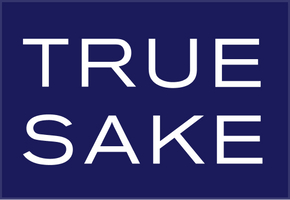Sake Endeavors – Den Sake From Oakland Prefecture
I love talking about sake. But I love being a part of sake even more. Meaning I love touching, smelling, and making sake. And not too long ago that could only be done in Japan, which is a world away. That was then and this is now, and I am very excited to share a new sake story with you coming out of Oakland, California.
Den Sake Brewery is the newest sake kura in the sake making game! And it is wise beyond its years. Why? Because the owner and brewer Yoshi Sako has been patiently learning, watching, and witnessing other brewing efforts and has been collecting advice and super insights on how to design his own sake brewery.
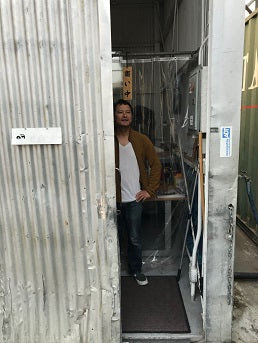 Yoshi has been in the Bay Area sake game for a long time. He has worked at restaurants that serve sake and also ran a sake retail store. And more importantly he was “home brewing” sake for several years, before throwing up his shingle at his current location in Oakland. His partner in crime and in life Lani is the backroom support driver that every small operation needs. Together, and with the help of some very good friends, they launched Den this year and the sky's the limit.
Yoshi has been in the Bay Area sake game for a long time. He has worked at restaurants that serve sake and also ran a sake retail store. And more importantly he was “home brewing” sake for several years, before throwing up his shingle at his current location in Oakland. His partner in crime and in life Lani is the backroom support driver that every small operation needs. Together, and with the help of some very good friends, they launched Den this year and the sky's the limit.
Recently I spent a day “brewing” with Yoshi and it was a great introduction to his world and the world of Den sake. It was also a good reminder of how I have personally witnessed the craft sake movement in North America. The first craft sake brewery that I shared time with was in Vancouver on Granville Island called O’Sake. This was that “oh my god” moment when I realized that small craft sake operations here were nothing like the countless breweries that I have visited and actually worked at in Japan. I’ll be honest, I was a little jaded and actually chuckled out loud when Masa showed me his Shubo “tank,” which was actually a large soup pot. No joke. It was a pretty funny realization, but it was perfect for that brewing environment.
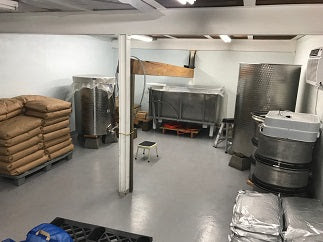 Then Jake and Noriko opened Sequoia Sake here in SF, and the “craft” operational layout took on a more professional “look,” with real sake equipment that looked the part, but at “half scale” to operations in Japan. In speaking to these two they say that they love their brewery, but they would have made certain changes and done things a little differently if they were to do it again. And it is these types of insights and discussions with others that has helped Yoshi take his own path. But machinery is not a sake brewery! Making sake IS a sake brewery! And Yoshi has had some amazing teachers.
Then Jake and Noriko opened Sequoia Sake here in SF, and the “craft” operational layout took on a more professional “look,” with real sake equipment that looked the part, but at “half scale” to operations in Japan. In speaking to these two they say that they love their brewery, but they would have made certain changes and done things a little differently if they were to do it again. And it is these types of insights and discussions with others that has helped Yoshi take his own path. But machinery is not a sake brewery! Making sake IS a sake brewery! And Yoshi has had some amazing teachers.
Several years ago I wrote in the Newsletter about discovering and coining the sake called “Cowboy Yamahai,” when I was on a trip to Niigata. I met a great sake brewery owner and toji named Shiokawa-san, who I would start a relationship with and who would eventually come to SF to visit True Sake and come to Sake Day. He is a good guy, and a great sake maker! He also would later write to thank me personally for, “Bringing him out of Japan to start a new energy in helping sake makers all over the world.” He thanked me for being his inspiration to travel abroad and to make a real effort to teach the sake making process to a new international generation of sake brewers. It made me feel pretty awesome, especially when one of his first students was Yoshi! So in some small way I felt like a little part of Den Sake when I went to go work for Yoshi in August.
 Den Sake Brewery is small. But it is not tiny. Den Sake Brewery is perfect for being “Den.” As Jake and Noriko discovered, when you lay out or game plan a brewery you’ll always make a mistake or two, and conversely you’ll always create a bonus or two by luck. That’s what is cool about designing your brewery. And Yoshi smiles a lot when he talks about his layout. I kept smiling too, because I kept finding cool little items or placement of things that are so smart, so perfect for that brewery. I also saw how Yoshi has implemented things that he has learned, and has created his own tricks that are needed for his environment. Examples? Sure!
Den Sake Brewery is small. But it is not tiny. Den Sake Brewery is perfect for being “Den.” As Jake and Noriko discovered, when you lay out or game plan a brewery you’ll always make a mistake or two, and conversely you’ll always create a bonus or two by luck. That’s what is cool about designing your brewery. And Yoshi smiles a lot when he talks about his layout. I kept smiling too, because I kept finding cool little items or placement of things that are so smart, so perfect for that brewery. I also saw how Yoshi has implemented things that he has learned, and has created his own tricks that are needed for his environment. Examples? Sure!
The koji room at Den is not small! It’s a certain kind of small. It is very narrow. The most narrow koji room that I have ever been in. This is not wrong! This is right, because Yoshi keeps learning how to make good koji rice in his narrow room. He has adapted to the narrowness. How? Well for one he has created several pieces of equipment that work perfectly in this narrow room. Since it is difficult to bend down or step back from the koji table Yoshi made an extender piece that makes a better boarder for the rice table that keeps all of the precious rice on the table and not spilling out on the floor. Secondly, Yoshi has created grommets on his cloth that holds his heated and active koji rice so he can fix the cloth to the wall in certain sections as he breaks the rice apart and places it into his 9kg koji trays. I’m a geek and this was simply geekish to the nth degree, and I simply loved it!
Oakland is not Japan. Yes, that was a newsflash. As such Yoshi has to work within a set of paradigms that Japanese brewers do not have to. The result is more adaptations to the limitations of not being in Japan. Not having this or that which is taken for granted in a brewing environment that is almost two thousand years old. So Yoshi, like Jake and Noriko, is a pioneer in that he is creating new ways to make sake outside of Japan. Example please? Sure! Yoshi met a sake maker from China who needed to keep his brewing rice fresh for a longer period of time. He created a method of putting a dehumidifier element in the rice bag then “shrink-wrapped” the entire sake bag in an airtight mylar skin. Awesome! And that is the soul of international craft sake making, taking a problem and making your own unique solution that helps a brewer to make better sake. I LOVE that!
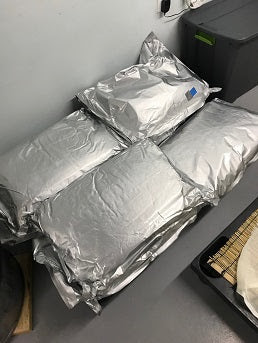 I could go on and on about his “koshiki” and his super table that he doesn’t value enough, but I saw the absolute necessity and dependence on a simple collapsible table. I could talk about his fune or press, which is awesome. Or I could mention other little tricks that he has incorporated to make great sake in his brewery, but maybe you should schedule a tour for yourself. Den is currently brewing their 3rd batch of sake and we are selling his 1st batch.
I could go on and on about his “koshiki” and his super table that he doesn’t value enough, but I saw the absolute necessity and dependence on a simple collapsible table. I could talk about his fune or press, which is awesome. Or I could mention other little tricks that he has incorporated to make great sake in his brewery, but maybe you should schedule a tour for yourself. Den is currently brewing their 3rd batch of sake and we are selling his 1st batch.
I will say that Yoshi is very proud of his rice farmers and has made a point to put their name on the front label and back label of each bottle of sake that he sells. I’ll say that I love his label for looking very clean and cool. I love the name Den for both the Japanese and English meanings. And I love Yoshi’s desire to not want to highlight what grade or category of sake that he makes. He doesn’t want to put Junmai on the label, because he feels westerners drink by category and not by quality. Meaning he doesn’t want to compete against consumers who just want to drink Daiginjo class sake. So he doesn’t put Muroka Nama Junmai on the label. He just puts Nama.
We started selling Den sake at True Sake on Thursday, August 9th, which was two days after our 15th Anniversary. Pretty cool to think that our futures are now connected, and I cannot wait until our 5th, 10th, and 15th anniversaries of selling Den sake to our awesome customers. Likewise, Yoshi will be pouring his Nama at Sake Day’18 this year, and hopefully we can get him to do an in-store tasting some time in October so you can meet and greet the future of sake.
DEN “Batch #1”
From Oakland, California. Nama. SMV: +3 Acidity: 1.3
The nose on this small brewery craft sake is made up of green apple, powdered sugar, sweet corn, and melon aromas. First of all, I LOVE typing Oakland for this review! Secondly, this sake drinks like any sake that you would find made by the best breweries in Japan. You are not “taking a chance” on this sake, but you are missing a chance to taste an excellent Muroka Nama Junmai if you don’t. Den drinks round, smooth, and full of rich flavors on a lively fluid that is very well balanced. Look for hints of vanilla, steamed rice, asian apple pear, and a lick of honey. There is a very nice acidity play that makes the sake pop even though it is on the rich side. This bright flavor full-bodied brew does well in a white wine glass, and it is lower in alcohol at 14%. WORD: Rich WINE: Deep reds/ Complex whites BEER: Full-Bodied Ales FOODS: Full-bodied fare, meats, fowl, game, international spice.
Good Luck Den!
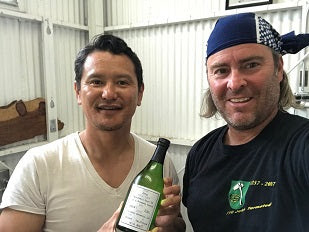
Ps. In rereading this article I forgot to mention a single grain of rice. Huh? It’s very odd but in a small brewing facility every single grain of rice counts. When I worked at bigger breweries if rice somehow pops out in the operational process it’s not a big deal. But when brewing at Den I was very cognizant that each grain of rice was extremely important, and it felt odd to see even one piece fall to the floor. Yoshi took extra efforts to take every grain of rice off of the storage bags, koji trays, and places where stray rice can find its way. Each grain of rice is so precious in a small operation like Den, and I think that this creates a “precious” perception for the way that they make their sake – one piece of rice at a time.
